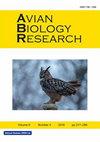Nest-site selection and nest design of Iberian bullfinches Pyrrhula pyrrhula iberiae in northwestern Spain
IF 1.2
4区 农林科学
Q4 AGRICULTURE, DAIRY & ANIMAL SCIENCE
引用次数: 3
Abstract
Nest-habitat selection and nest design in a Eurasian bullfinch population in the Iberian Peninsula are thoroughly addressed in this study for the first time. Hedgerows and meadows were found around all of the nests and most of them were supported by hedgerows, so bullfinches consistently used the general woody vegetation available as reproduction habitat and site. Also, poplar plantations appeared preferentially in the immediate surroundings of the nests. Partly reflecting these results, bullfinches chose zones with greater shrub and tree cover than that available. Bullfinches placed their nests on a wide variety of plant species, but showed predilection for thorny species. Overall mean height of nests above the ground was 1.43 m and large-sized shrubs/trees were preferred. The most predominant bullfinch nest orientations were S, E and centered, which arguably provided thermal benefits and protected from severe weather. In general, there were no significant temporal variations in nest-site selection. With the exception of thorny support and favourable orientation, acting jointly, there was no significant association between nest-site characteristics and nesting success, presumably because many nests were already located in the most advantageous places at each time, and because despite this, predation pressure was high. Nest external dimensions were relatively variable, whereas internal width was the least variable nest dimension. No significant monthly or interannual variations in nest weight were observed. Larger nests did not hold larger clutches. Successful nests were larger than unsuccessful ones. The bullfinch nests were of simple construction, with two clearly different regions, the outer nest and the internal cup, with no significant temporal variations in the weight of either. The outer, structural nest consisted mainly of twigs, whereas roots and herbaceous shoots were the highest fractions lining the cup. Hair was the only animal-derived material used by bullfinches.西班牙西北部伊比利亚斗牛犬的巢址选择和巢设计
本文首次深入研究了伊比利亚半岛欧亚红腹灰雀种群的巢生境选择和巢设计。所有的巢周围都有树篱和草甸,大多数巢都有树篱支撑,所以红腹灰雀一直使用一般的木本植被作为繁殖的栖息地和地点。杨树人工林也优先出现在燕窝周围。在一定程度上反映了这些结果,红胸草雀选择了灌木和树木覆盖面积更大的地区。红腹灰雀在各种各样的植物上筑巢,但对多刺的植物表现出偏爱。巢距地面总平均高度为1.43 m,以大型灌木/乔木为宜。最主要的红腹灰雀巢的朝向是S, E和居中,这可以提供热量和保护免受恶劣天气的影响。一般来说,巢址选择没有显著的时间变化。除了有刺的支持和有利的方向,共同作用,筑巢地点特征和筑巢成功之间没有显著的联系,可能是因为每次都有许多巢穴已经位于最有利的地方,尽管如此,捕食压力还是很高的。巢的外部尺寸变化相对较大,而内部宽度是变化最小的巢尺寸。巢重未见明显的月度或年际变化。更大的巢不能容纳更多的幼崽。成功的巢比不成功的巢大。红腹灰雀的巢结构简单,有两个明显不同的区域,外巢和内杯,两者的重量都没有明显的时间变化。外部的结构巢主要由树枝组成,而根和草本芽是杯状结构的最高部分。毛发是红腹灰雀使用的唯一来源于动物的材料。
本文章由计算机程序翻译,如有差异,请以英文原文为准。
求助全文
约1分钟内获得全文
求助全文
来源期刊

Avian Biology Research
农林科学-奶制品与动物科学
CiteScore
1.50
自引率
0.00%
发文量
17
审稿时长
2 months
期刊介绍:
Avian Biology Research provides a forum for the publication of research in every field of ornithology. It covers all aspects of pure and applied ornithology for wild or captive species as well as research that does not readily fit within the publication objectives of other ornithological journals. By considering a wide range of research fields for publication, Avian Biology Research provides a forum for people working in every field of ornithology.
 求助内容:
求助内容: 应助结果提醒方式:
应助结果提醒方式:


